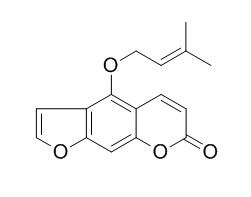Natural Products
Isoimperatorin
| Catalog No. | CFN99107 |  |
| CAS No. | 482-45-1 | |
| Molecular Weight: | 270.28 | |
| Molecular Formula | C16H14O4 | |
| DBs | [PubChem]:274951311 [ChEMBL]:66071 [PCIDB]:30532 |
Standard InChI:
InChI=1S/C16H14O4/c1-10(2)5-7-19-16-11-3-4-15(17)20-14(11)9-13-12(16)6-8-18-13/h3-6,8-9H,7H2,1-2H3
Biological Activity
Isoimperatorin is a medicinal herbal product that is isolated from the dried roots of Angelicae dahuricae ,can inhibit the cyclooxygenase-2 (COX-2) and COX-1-dependent phases of prostaglandin D 2 (PGD 2 ) generation in bone marrow-derived mast cells (BMMC) in a concentration-dependent manner, with IC 50 values of 10.7 μM and 24 μM, respectively; it may provide the basis for novel anti-inflammatory drugs.[1]
Isoimperatorin possesses a potent hepatoprotective effect against AFB1, presumably through the induction of GSTalpha and the direct inhibition of CYP1A at 2 microM concentration , and suggests that it should be considered a potential chemopreventive.[2]
Isoimperatorin isolated from Cimicifugae Rhizome selectively inhibits TNF-α-induced expression of VCAM-1 at least by upregulation of PPAR-γ, and signals for ERK1/2, PI3K, and PKC are involved in this effect.[3]
Isoimperatorin (IO) has antimycobacterial activity against Mycobacterium tuberculosis strain H37Rv (ATCC 27294), IO has antimycobacterial activity against 2 drug-sensitive and 6 drug-resistant isolates, with minimum inhibitory concentrations (MICs) of 50-100 ug ml(-1) and 100-200 ug ml(-1), respectively; and IO exhibits synergistic antimycobacterial effects with rifampin (RMP), isoniazid (INH) and ethambutol (EMB) against 6 drug-resistant strains, with fractional inhibitory concentration index (FICI) values of 0.133–0.472, 0.123–0.475 and 0.124–0.25, respectively.[4]
Product
References
[1] Moon T, Jin M, Son J, et al. Arch Pharml Res, 2008, 31(2):210-5.
[2] Pokharel Y R, Han E H, Kim J Y, et al. Carcinogenesis, 2006, 27(12):2483-90.
[3] Lidiya Moon, Yu Mi Ha, Hwa Jin Jang,et al. J Ethnopharmacol, 2011, 133(2):336-44.
[4] N. Guo †, J. Wu †, Fan J, et al. Lett Appl Microbiol, 2014, 58(4):344–9.
[5]Yong Chen, Yinchi Jin, Yifen Chen, et al. J Liq Chromatogr R T, 2009, 32(16):2384-95.
Product Use Citation





